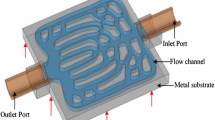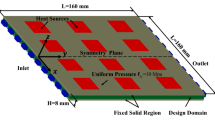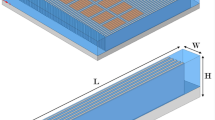Abstract
In topology optimization of the microchannel heat sink, the minimum width of flow channels are constrained by the mesh size. To reduce the constraint of finite element mesh on the optimized structure, this paper proposes a mesh adaptive strategy which consists of finer ground mesh and coarser adaptive mesh for the heat sink design. The nodes of adaptive mesh are selected from ground mesh based on the structure of current iteration. The physical fields are solved on adaptive mesh, and design variables are updated on ground mesh. Besides, hyperparameters are introduced to control the adaptive degree, and their influence on optimized results is analysed in detail. Numerical experiments with simplified two-layer thermal-fluid model and parametric level set method show that the developed method outperforms traditional uniform mesh and is able to save large amounts of computing resources.















Similar content being viewed by others
References
Allaire G, Jouve F, Toader AM (2004) Structural optimization using sensitivity analysis and a level-set method. J Comput Phys 194(1):363–393
Allaire G, Dapogny C, Frey P (2013) A mesh evolution algorithm based on the level set method for geometry and topology optimization. Struct Multidisc Optim 48:711–715
Borrvall T, Petersson J (2003) Topology optimization of fluids in stokes flow. Int J Numer Methods Fluids 41:77–107
Buhmann MD (2004) Radial basis functions: theory and implementations Cambridge monographs on applied and computational mathematics. Cambridge University Press, Cambridge, p 12
Cheng AD, Golberg MA (2003) Exponential convergence and H-c multiquadric collocation method for partial differential equations. Numer Math D E 19(5):571–594
Choi KK, Kim NH (2005) Structural sensitivity analysis and optimization - linear systems. Springer, New York
Duan X, Li F, Qin X (2015) Adaptive mesh method for topology optimization of fluid flow. Appl Math Lett 44:40–44
Feppon F, Allairea G, Dapognyc C et al (2021) Body-fitted topology optimization of 2D and 3D fluid-to-fluid heat exchangers. Comput Methods Appl Mech Eng 376:113638
Garimella SV, Fleischer AS, Murthy JY (2008) Thermal challenges in next-generation electronic systems. IEEE Trans Compon Packag Technol 31(4):801–815
Gersborg-Hansen A, Sigmund O, Haber RB (2005) Topology optimization of channel flow problems. Struct Multidisc Optim 30:181–192
Gong L, Zhao J, Huang Sh (2015) Numerical study on layout of micro-channel heat sink for thermal management of electronic devices. Appl Therm Eng 88:480–490
Grujicic M, Zhao CL, Dusel EC (2005) The effect of thermal contact resistance on heat management in the electronic packaging. Appl Surf Sci 246:290–302
Guo X, Zhang W, Zhong W (2014) Doing topology optimization explicitly and geometrically - a new moving morphable components based framework. J Appl Mech 81:1–13
Haertel JHK, Engelbrecht K, Lazarov BS, Sigmund O (2018) Topology optimization of a pseudo 3D thermofluid heat sink model. Int J Heat Mass Transf 121:1073–1088
Han X, Liu H, Xie G (2021) Topology optimization for spider web heat sinks for electronic cooling. Appl Ther Eng 195:1–12
Koga AA, Lopes ECC, Nova HFV (2013) Development of heat sink device by using topology optimization. Int J Heat Mass Transf 64(3):759–772
Larson MG, Bengzon F (2014) The finite element method: theory, implementation, and applications. Springer, London
Lau JH (2014) Overview and outlook of three-dimensional integrated circuit packaging, three-dimensional Si integration, and three-dimensional integrated circuit integration. J Electron Packag Trans ASME 136:1–15
Lee J, Mudawar I (2009) Critical heat flux for subcooled flow boiling in micro-channel heat sinks. Int J Heat Mass Transf 52(13–14):3341–3352
Li H, Yamada T, Jolivet P et al (2020) Full-scale 3D structural topology optimization using adaptive mesh refinement based on the level-set method. Struct Multidiscip Optim 194:1–17
Li H, Kondoh T, Jolivet P et al (2022) Optimum design and thermal modeling for 2D and 3D natural convection problems incorporating level set-based topology optimization with body-fitted mesh. Numer Methods Eng 123:1954–1990
Luo Z, Wang MY, Wang SY, Wei P (2008) A level set-based parametrization method for structural shape and topology optimization. Int J Numer Meth Eng 76:1–26
Luo Z, Tong L, Kang Z (2009) A level set method for structural shape and topology optimization using radial basis functions. Comput Struct 87(7–8):425–434
Olesen LH, Okkels F, Bruus H (2006) A high-level programming-language implementation of topology optimization applied to steady state Navier-Stokes flow. Int J Numer Meth Eng 65:975–1001
Osher S, Fedkiw R (2003) Level set methods and dynamic implicit surfaces. Springer, London
Othmer C (2008) A continuous adjoint formulation for the computation of topological and surface sensitivities of ducted flows. Int J Numer Methods Fluids 58:861–877
Panesar A, Brackett D, Ashcroft I, Wildman R, Hague R (2017) Hierarchical remeshing strategies with mesh mapping for topology optimisation. Int J Numer Methods Eng 111(7):676–700
Papoutsis-Kiachagias EM, Giannakoglou KC (2014) Continuous adjoint methods for turbulent flows, applied to shape and topology optimization: industrial applications. Arch Comput Meth Eng 23:255–299
Romão E, Moura L (2012) Galerkin and least squares methods to solve a 3D convection-diffusion-reaction equation with variable coefficients. Numer Heat Transf Pt A-app 61:669–698
Sato Y, Yaji K, Izui K (2017) An optimum design method for a thermal-fluid device incorporating multi objective topology optimization with an adaptive weighting scheme. J Mech Des 140(3):031402
Sturler ED, Paulino GH, Wang S (2008) Topology optimization with adaptive mesh refinement. Comput Shell Spatial Struct 11:28–31
Suna Y, Fengwen W, Jun H (2019) Topology optimization of microchannel heat sinks using a two-layer model. Int J Heat Mass Transf 143:1–16
Svanberg K (1987) The method of moving asymptotes—a new method for structural optimization, International Journal for Numerical Methods in Engineering 24(2):359–373.
Tuckerman DB, Pease RFW (1981) High-performance heat sinking for VLSI. IEEE Electron Dev Lett 2(5):126–129
Wang MY, Xm Wang, Dm Guo (2003) A level set method for structural topology optimization. Comput Methods Appl Mech Eng 192:227–246
Wang S, Sturler ED, Paulino GH (2010) Dynamic adaptive mesh refinement for topology optimization. Int J Comput Vision 1:1–24
Wang Y, Kang Zh, He Q (2014) Adaptive topology optimization with independent error control for separated displacement and density fields. Comput Struct 135:50–61
Wendland H (1995) Piecewise polynomial, positive definite and compactly supported radial functions of minimal degree. Adv Comput Math 4(1):389–396
Wendland H (2006) Computational aspects of radial basis function approximation. Comput Math 12:231–256
Yaji K, Yamada T, Kubo S (2014) A topology optimization method for a coupled thermal-fluid problem using level set boundary expressions. Int J Heat Mass Transf 81:878–888
Yu M, Ruan K, Wang X (2019) Topology optimization of thermal-fluid problem using the MMC-based approach. Struct Multidiscip Optim 60:151–165
Zhang T (2022) Yang Xq., Parametrized level set method for a coupled thermal-fluid problem using radial basis functions. Appl Therm Eng 213:1–14
Zhang T, Yang X (2022) Level set-based topology optimization for thermal-fluid system based on the radial basis functions. Appl Math Model 113:1–12
Zhang W, Li D, Zhou J, Du Z, Li B, Guo X (2018) A moving morphable void (MMV)-based explicit approach for topology optimization considering stress constraints. Comput Methods Appl Mech Eng 334:381–413
Zhang T, Fu Y, Yang X (2022) A pseudo 3D cooling heat sink model designed by multi-objective topology optimization method. Meccanica 57:1–16
Zhao J, Zhang M, Zhu Y (2021) Topology optimization of planar cooling channels using a three-layer thermofluid model in fully developed laminar flow problems. Struct Multidiscip Optim 63:2789–2809
Zhao J, Zhang M, Zhu Y (2021) Topology optimization of planar cooling channels using a three-layer thermofluid model in fully developed laminar flow problems. Struct Multidisc Optim 63:2789–2809
Zou A, Chuan R, Qian F (2020) Topology optimization for a water-cooled heat sink in micro-electronics based on Pareto frontier. Appl Ther Eng 207:1–13
Funding
This work was supported by High tech ship research project of ministry of industry and information technology JJT(2019)(No. 357 of MIT) and Key Special Project for Introduced Talents Team of Southern Marine Science and Engineering Guangdong Laboratory (GML2019ZD0502).
Author information
Authors and Affiliations
Corresponding author
Ethics declarations
Conflicts of interest
The authors declare that there are no known conflicts of interest.
Replication of results
The proposed method is built on the exisiting mesh adaptation scheme and simplified two-layer heat sink topology optimization method, the combination of which has been fully expounded in this work. On behalf of all authors, the corresponding author states that the results presented in this paper can be reproduced by the implementation details provided. The authors wish to withhold the codes of finite element models for commercialization purposes. The MATLAB code for optimization is acquired from its author Svanberg. Thus, only an example of proposed method written in MATLAB is provided.
Additional information
Responsible Editor: Joe Alexandersen
Publisher's Note
Springer Nature remains neutral with regard to jurisdictional claims in published maps and institutional affiliations.
Rights and permissions
Springer Nature or its licensor (e.g. a society or other partner) holds exclusive rights to this article under a publishing agreement with the author(s) or other rightsholder(s); author self-archiving of the accepted manuscript version of this article is solely governed by the terms of such publishing agreement and applicable law.
About this article
Cite this article
Zhang, T., Yang, X. & Wang, X. Mesh adaptive-based parametric level set method for the design of heat sink based on two-layer thermal-fluid system. Struct Multidisc Optim 67, 80 (2024). https://doi.org/10.1007/s00158-024-03790-2
Received:
Revised:
Accepted:
Published:
DOI: https://doi.org/10.1007/s00158-024-03790-2




